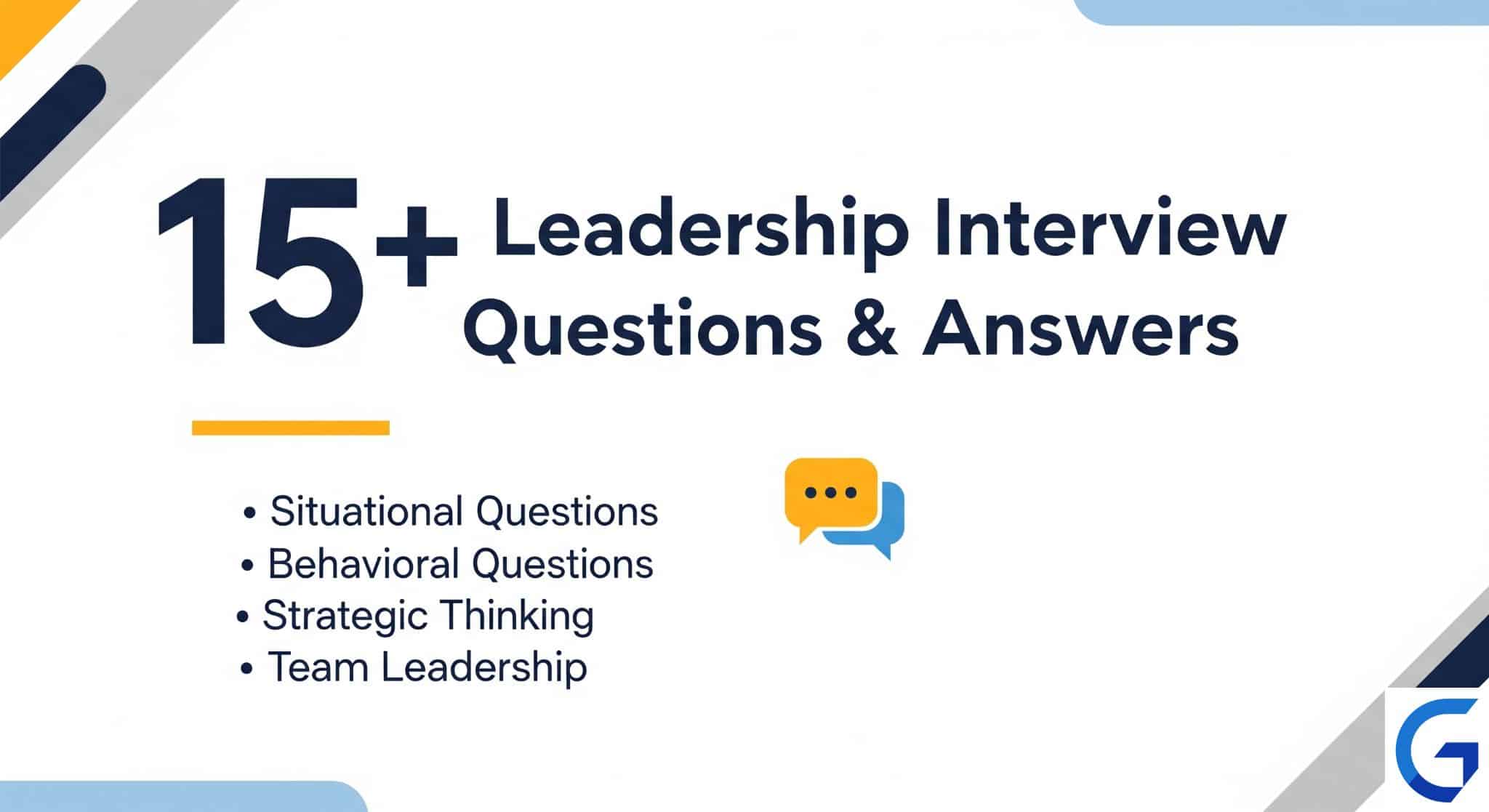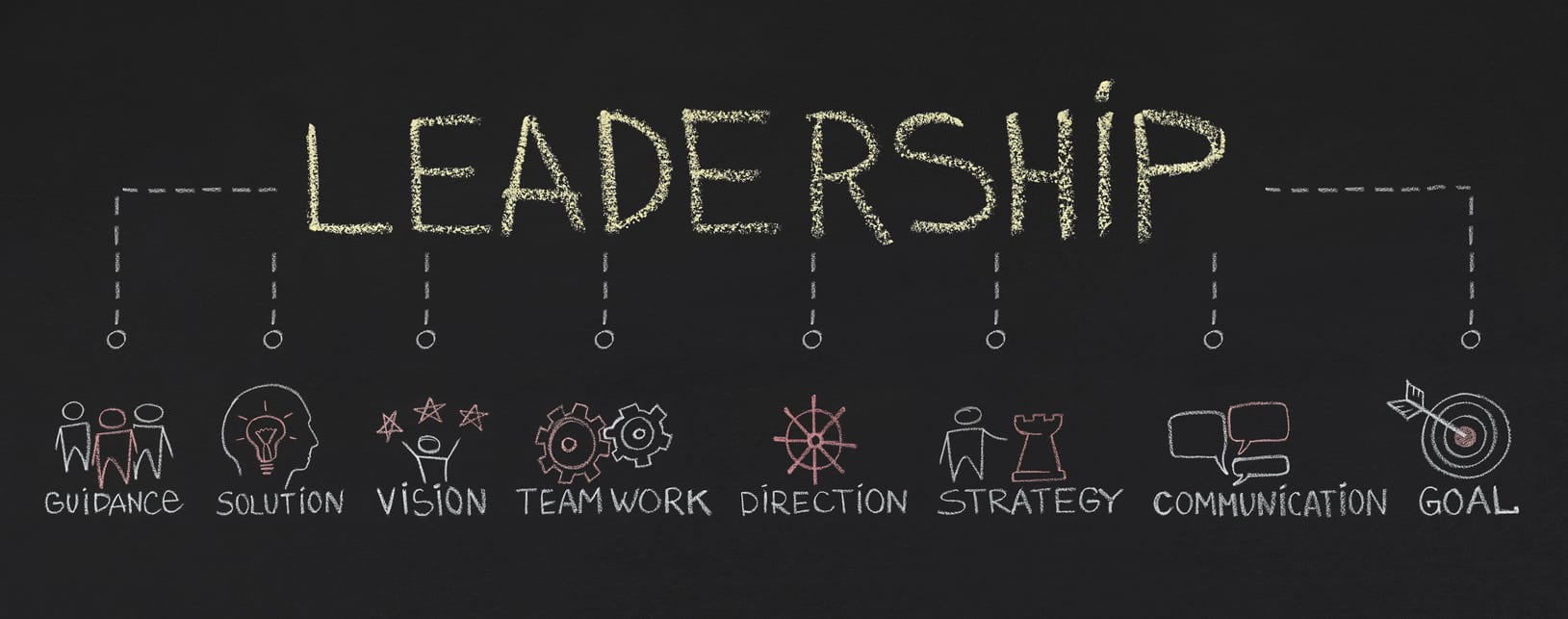- 1. Tell me about a time you failed.
- 2. How do you motivate a team?
- 3. Describe a time you had to deal with a conflict between team members.
- 4. Walk me through how you deliver difficult feedback.
- 5. Tell me about a time you had to make a tough decision with incomplete information.
- 6. How do you support the professional growth of your team members?
- 7. Describe a time you had to persuade stakeholders to agree with your vision.
- 8. How do you delegate tasks?
- 9. Tell me about a time you led your team through a significant change.
- 10. What is your leadership style?
- More Questions (Rapid Fire Style):
Leadership isn't about a title or just telling people what to do. It's the practical ability to influence, motivate, and enable a team to achieve a goal they couldn't reach on their own. Real leadership means taking full ownership when things fail and passing the credit to your team when things succeed.
To find people who can actually do this, hiring managers don't ask simple questions. They use specific behavioral questions to dig into your past actions, believing they predict future performance. This guide breaks down what they're really asking behind the fluff. We will cover the most common leadership questions and give you a straightforward framework to answer them with substance.
Free Leadership and Management Course
Learn the essential skills to inspire your team, plan effectively, and achieve your objectives. Enroll now and become a better leader with our free Leadership & Management Course.
First, the only framework you need: The STAR Method. Every single behavioral question should be answered this way.
- S - Situation: Set the scene. Briefly, what was the context? (1-2 sentences)
- T - Task: What was your specific responsibility or goal? (1 sentence)
- A - Action: What specific steps did you take? Use "I," not "we." This is the most important part. Detail your process.
- R - Result: What was the outcome? Quantify it. Use numbers, percentages, and data. Show the impact.
Master this, and you're already ahead of 90% of candidates. Let's get into the questions.
1. Tell me about a time you failed.
What they're really asking: Are you self-aware? Do you take accountability, or do you blame others? What did you learn from a real failure, not a fake "my weakness is I work too hard" answer.
Answer Structure:
- S (Situation): Early in my career as a project lead, I was managing the launch of a new software feature. We had a hard deadline set by marketing.
- T (Task): My goal was to deliver the feature on time. I was overly optimistic and focused only on the deadline.
- A (Action): I pushed the team hard, approved shortcuts in the code to save time, and ignored a junior developer's concerns about potential bugs. I focused on speed over quality because I didn't want to admit we were falling behind schedule.
- R (Result): We hit the deadline, but the launch was a disaster. The feature was riddled with bugs, causing a 20% spike in customer support tickets. We had to roll it back within 48 hours. I learned that true leadership isn't just about hitting deadlines; it's about listening to your team and protecting the quality of the work. I now implement mandatory code reviews and pre-launch "what-if" sessions for every project.
2. How do you motivate a team?
What they're really asking: Do you understand that motivation isn't about pizza parties? Can you connect work to a larger purpose and support individuals' career goals?
Answer Structure:
- S (Situation): My team was tasked with a six-month-long data migration project. It was critical work but repetitive and morale was dipping a month in.
- T (Task): I needed to re-engage the team and ensure we maintained high quality throughout the project's lifecycle.
- A (Action): I broke my approach into two parts. First, clarity of purpose: I organized a meeting with the head of analytics who showed us exactly how this migration would enable three major new business initiatives. This connected their tedious work to a tangible company impact.
Second, individual growth: I met with each team member 1-on-1. I learned one person wanted to get into cloud architecture, so I tasked them with leading the AWS integration part of the project. Another wanted to improve their Python skills, so I had them write the validation scripts. - R (Result): Team engagement scores improved by 30% over the next quarter. We completed the project a week ahead of schedule with a 99.8% data accuracy rate. Two team members were able to use their new project experience to move into more senior roles within the year.
Also Read: Leader vs Boss: What's the Difference?
3. Describe a time you had to deal with a conflict between team members.
What they're really asking: Do you avoid conflict or address it directly? Can you mediate impartially and find a productive solution?
Answer Structure:
- S (Situation): I had two senior engineers on my team with a conflict. One wanted to use a new, faster framework for a project, while the other insisted on using our existing, stable tech stack to minimize risk. It was halting progress and making team meetings tense.
- T (Task): My job was to resolve the technical disagreement and restore a professional working relationship.
- A (Action): I first met with each engineer separately to understand their perspective without interruption. It became clear one valued innovation and the other valued stability. Then, I brought them together. I set a rule: no personal attacks, only technical arguments. I framed the goal not as "who wins" but as "what is the best decision for the project." I had them list the objective pros and cons of each approach on a whiteboard.
- R (Result): They agreed on a hybrid solution: we would use the existing stack for the core functionality but build a small, non-critical feature using the new framework as a pilot. This balanced risk and innovation. The project was completed successfully, and it set a precedent for how we evaluate new technology as a team.
4. Walk me through how you deliver difficult feedback.
What they're really asking: Can you be direct and honest without being a jerk? Do you focus on behavior and impact, not personality?
Answer Structure:
- S (Situation): A talented analyst on my team was producing great work, but they were consistently missing deadlines, which delayed the entire team's reporting cycle.
- T (Task): I needed to address the missed deadlines directly to correct the behavior while retaining a valuable team member.
- A (Action): I scheduled a private 1-on-1. I started by stating my observation, not an accusation: "I've noticed that in the last three sprints, your reports have been submitted one to two days past the deadline." I then stated the impact: "When this happens, the rest of the team is blocked and we risk delivering our consolidated report to leadership late." I then paused and asked an open question: "Can you walk me through what's happening?" The employee admitted to struggling with over-analysis. We co-created a plan with smaller, more frequent check-ins to ensure they were on track.
- R (Result): In the next sprint, the analyst hit all their deadlines. Within two months, the check-ins were no longer necessary. Their performance remained high, and they later told me they appreciated how the feedback was handled because it felt like I was trying to solve the problem with them, not just criticizing them.
5. Tell me about a time you had to make a tough decision with incomplete information.
What they're really asking: Can you handle ambiguity? What's your process for making a calculated risk? Do you freeze up or act?
Answer Structure:
- S (Situation): We had an opportunity to bid on a major client contract, but the request for proposal (RFP) had a very tight deadline—we only had 48 hours to decide to pursue it and commit resources. We didn't have full visibility into the project's technical requirements.
- T (Task): I had to make the go/no-go decision on whether to dedicate a team to a multi-week proposal effort.
- A (Action): I couldn't get all the information, so I focused on de-risking the unknown. I time-boxed the problem. I assembled a small "tiger team" with leads from engineering, sales, and finance for one hour. I asked each person one question: "What is the biggest risk from your perspective, and what's the most likely worst-case scenario?" Engineering was worried about scale, finance about low margins. I weighed the potential reward (a flagship client) against the identified risks.
- R (Result): I made the decision to go for it, but with a condition: the proposal would include tiered pricing based on different performance levels, protecting our margins. We won the contract, and it turned into a 3-year, multi-million dollar engagement. The key was making a decision based on the best available information, not waiting for perfect information that would never come.
6. How do you support the professional growth of your team members?
What they're really asking: Do you just manage tasks, or do you develop people? Are you invested in your team's future, even if it means they eventually leave your team?
Answer Structure:
"I see developing people as a core function of my role. My approach is structured around three key actions. First, I establish a Personal Development Plan (PDP) with each team member quarterly. This is their plan, not mine. I ask them where they want to be in 2 years and we work backward to identify skills they need. Second, I find opportunities in daily work. If someone wants to learn project management, I'll have them lead a small internal project.
Growth shouldn't be separate from the job. Third, I advocate for them. I make sure their successes are visible to senior leadership and I actively look for opportunities for them, like attending a key conference or presenting their work at a company-wide meeting. For example, I had a developer who was interested in public speaking. We worked together on a presentation for a small internal tech talk. Six months later, I championed them to present at a major industry conference."
7. Describe a time you had to persuade stakeholders to agree with your vision.
What they're really asking: Can you influence people without direct authority? Do you use data and logic to build a case?
Answer Structure:
- S (Situation): I proposed that our department should invest in a new analytics software that would cost $50,000 per year. The leadership team was skeptical because our current, free tools were considered "good enough."
- T (Task): I needed to convince the CFO and the Head of Operations that the investment was worth it.
- A (Action): I didn't lead with my opinion. I led with data. I ran a two-week pilot with a free trial of the new software. I calculated that my team spent, on average, 8 hours per person per week manually pulling and cleaning data with the old tools. The new software cut that down to 1 hour. I translated that time into money: I showed that we were losing approximately $120,000 a year in wasted productivity. I presented this data in a simple, one-page document. I addressed their specific concerns: for the CFO, I framed it as a 2.4x ROI. For the Head of Ops, I framed it as a 7-hour per week productivity gain that could be reallocated to higher-value analysis.
- R (Result): The stakeholders unanimously approved the purchase. Within six months of implementation, my team was able to produce insights that identified a new revenue stream worth over $250,000.
8. How do you delegate tasks?
What they're really asking: Do you micromanage or do you trust your team? Do you provide enough context and support for them to succeed?
Answer Structure:
"My delegation philosophy is 'context, not control.' For example, when we needed to create a new client onboarding process, I didn't just tell a team member to 'go figure it out.' First, I provided the context and the 'why'. I explained that our current process was inefficient and leading to a 15% client churn in the first 90 days. The goal was to reduce that. Second, I defined the 'what' but not the 'how'.
I set the clear deliverable: 'Create a documented process that reduces the number of client touchpoints from ten to five and can be executed by any member of the team.' Third, I confirmed resources and alignment. I asked, 'What do you need from me to be successful?' and we agreed on a check-in schedule. I delegated the outcome, not the tasks. This gives the person ownership and allows them to bring their own creativity to the solution."
9. Tell me about a time you led your team through a significant change.
What they're really asking: Can you manage uncertainty and keep a team focused during a chaotic time (like a re-org, a new strategy, or a merger)?
Answer Structure:
- S (Situation): Our company was acquired, and our 15-person team was being merged with a 25-person team from the acquiring company. There was a lot of fear about layoffs and process changes. Productivity dropped.
- T (Task): My primary goal was to merge the two teams, stabilize morale, and establish a unified, productive culture.
- A (Action): I focused on communication and clarity. First, I held a team-wide meeting to address the uncertainty head-on. I shared everything I knew about the new structure and was honest about what I didn't know yet. Second, I immediately established a weekly "merger update" Q&A session. Third, instead of imposing a new process, I created a joint task force with members from both original teams to design our new, combined workflow. This gave them ownership over the change instead of having it forced on them.
- R (Result): While the broader company saw a 20% attrition rate during the merger, my newly combined team only lost one person. Within three months, we had successfully integrated our systems and our team's productivity metrics exceeded pre-merger levels by 10%.
10. What is your leadership style?
What they're really asking: Don't give a one-word answer like "servant" or "democratic." Tell a story that shows how you lead and what you value.
Answer Structure:
"I would describe my style as situational and transparent. I adapt my approach to the needs of the team and the individual. For an experienced, senior team member, I'm hands-off. I provide the strategic context and then I trust them to execute. For a junior member, I'm more of a coach. I'll provide more structure and have more frequent check-ins to ensure they feel supported.
For example, on my last project, I had a senior developer leading a critical component. I gave her full autonomy. At the same time, I had a new hire on the team. I paired them with the senior dev as a mentor but also worked with the new hire daily to break down their tasks and review their progress. Underpinning all of this is transparency. The team always knows what I know about project deadlines, business goals, and challenges. I believe that when people have context, they make better decisions."
Also Read:
More Questions (Rapid Fire Style):
11. How do you hold team members accountable?
A: "Accountability starts with clarity. In sprint planning, we don't just assign tasks, we agree on what 'done' looks like, with measurable outcomes. Accountability isn't about blaming; it's a conversation. If a deadline is missed, my first question is 'What obstacles are you facing?' not 'Why are you late?'"
12. How do you help your team manage conflicting priorities?
A: "I help the team prioritize based on impact and effort. We use a simple matrix: High-Impact/Low-Effort (do it now), High-Impact/High-Effort (plan it carefully), Low-Impact/Low-Effort (do it if there's time), and Low-Impact/High-Effort (question why we're doing it at all). I see my role as a shield, protecting the team from low-impact 'urgent' requests so they can focus on what matters."
13. Tell me about a time you had to go against a company policy.
A: "A client had a critical production issue, but our policy required a multi-day approval process to deploy a hotfix. I made the call to bypass the process and deploy the fix immediately. I documented every step, communicated to all stakeholders what I was doing and why, and immediately followed up with a post-mortem to improve the policy itself. It was a calculated risk to prioritize the customer, and it led to a formal change in our emergency deployment policy."
14. What's an area of your leadership you're working on improving?
A: "I'm actively working on being a better delegator of high-stakes tasks. Historically, if something was critical, my instinct was to do it myself to ensure it was done 'right.' I've learned this doesn't scale and it robs my team of growth opportunities. So now, I'm intentionally identifying one critical task per quarter to delegate, and I'm providing deep support and mentorship to that person rather than just taking over."
15. What do you do if your team is falling behind on a project?
A: "First, I diagnose the 'why.' I don't just tell them to work harder. I dig in to see if the problem is an unrealistic timeline, technical debt, or external roadblocks. Once I know the root cause, I present leadership with options, not problems. For example: 'We can hit the deadline if we cut feature X, or we can deliver the full scope if we move the deadline by two weeks.' I make the trade-offs clear and recommend a path forward."






